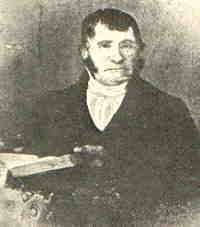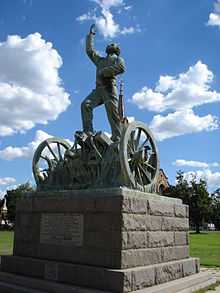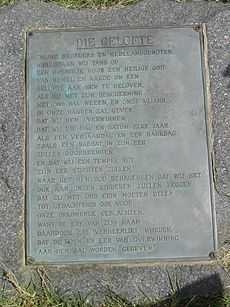Sarel Cilliers
| Sarel Cilliers | |
|---|---|
 | |
| Personal details | |
| Born | Charl Arnoldus Cilliers[1] 7 September 1801 Schoongezicht farm, Paarl, Cape Colony[1] |
| Died | 4 October 1871 (aged 70) Doornkloof farm, Lindley, Orange Free State[1] |
| Resting place | Doornkloof farm 27°43′36″S 27°41′53″E / 27.72667°S 27.69806°E |
| Spouse(s) | Anna Francina Viljoen (1801–)[1] |
| Parents | Carel Cilliers, Elizabeth Catherine Louw |
| Residence | Doornkloof |
| Occupation | Spiritual leader/Preacher, later a church elder and Councillor |
| Religion | Protestant (Dutch Reformed Church) |
| Military service | |
| Allegiance | |
| Commands | Transvaal and Orange River Commandos |
| Battles/wars | Battle of Blood River |
Charl (Sarel) Arnoldus Cilliers (1801–1871) was a Voortrekker leader and a preacher. With Andries Pretorius, he led the Boers to a huge victory over the Zulus at the Battle of Blood River in 1838. In particular, Cilliers lead the Voortrekkers in a vow which promised that if God would protect them and deliver the enemy into their hands, they would build a church and commemorate the day of their victory as if it were an annual Sabbath day, which their descendants would also be instructed to honour.
He was a prominent member of the Gereformeerde Kerk (Reformed Church), an offshoot of the Dutch Reformed Church. He is described as being a short, stout man, and was believed to have been very religious. He joined the Great Trek at the age of thirty-five.[2]
The town of Kroonstad was, according to folklore, named after a horse belonging to Cilliers, which drowned in a stream (Kroonspruit) where the town is situated.
There is a Sarel Cilliers Museum as well as a statue of him (on the site of the Dutch Reformed Church) in Kroonstad. Numerous streets and roads in Kroonstad and throughout South Africa are named after him.
Early life
Sarel Cilliers was born the fourth of seven children in Schoongezicht, Cape Colony to Carel Cilliers and his wife, Elizabeth Catherine Louw.[3] In 1806 his parents sold Schoongezicht, when Cilliers was five years of age.
From an early age he was well-acquainted with working life on the family farm, as he would often help with pastoral and elementary responsibilities. In his early life, he also developed a strong sense of community and religious duty. On Sundays, the neighbours gathered together to hold services and Holy Communion. It was in his childhood that Cilliers's religious values and aptitude for spiritual leadership were first developed, as he was said to have had a personal encounter with God at age 10. He would often share his faith with other children and encourage them to worship, and strengthen their bond with God.
On 6 October 1823, Cilliers married Anna Francina Viljoen, the daughter of Christopher and Aletta Viljoen Booysen. Cilliers fathered eleven children from his marriage to Anna. During his younger years, Cilliers was of a slim build, and it was only later in his life around the time of the Greak Trek that he became stouter in appearance.
The Great Trek

In 1829, the Cilliers family moved to New Hantam (today Colesberg). In 1835, a drought hit the local area, and this led to Cilliers joining the Great Trek with his wife and six children in 1836, as he was convinced that it was God's will that he should go.
Cilliers was made the unofficial pastor of the Great Trek, and he would hold services on a daily basis and give Sunday Communion. During the Great Trek he became distinguished as a spiritual leader, earning him such names as The Prophet of the Great Trek and The Father of Dingaansdag (Dingane's Day). In 1837, he was appointed to one of the two deacons of the first church council elected in the commissioned commandos.
Renowned for his ability of boosting the morale of members of the Great Trek during times of hardship, he would often inspire troops through his recital of the Lord's Prayer during conflict. His skills of fortifying the troops were best displayed at the Battle of Blood River, where he spoke the famous vow to God on the battlefield, and held a thanksgiving service after the decisive victory over the Zulus. Cilliers' vow was celebrated as a national holiday in South Africa (Day of the Vow) on 16 December until 1994.
The Vow

No verbatim record of the vow exists. The version often considered to be the original vow is in fact W.E.G. Louw's ca. 1962 translation into Afrikaans of G.B.A. Gerdener's reconstruction of the vow in his 1919 biography of Sarel Cilliers.[4]
The wording of the Vow is:
Afrikaans: Hier staan ons voor die Heilige God van hemel en aarde om ʼn gelofte aan Hom te doen, dat, as Hy ons sal beskerm en ons vyand in ons hand sal gee, ons die dag en datum elke jaar as ʼn dankdag soos ʼn Sabbat sal deurbring; en dat ons ʼn huis tot Sy eer sal oprig waar dit Hom behaag, en dat ons ook aan ons kinders sal sê dat hulle met ons daarin moet deel tot nagedagtenis ook vir die opkomende geslagte. Want die eer van Sy naam sal verheerlik word deur die roem en die eer van oorwinning aan Hom te gee.
English: Here we stand before the holy God of heaven and earth, to make a vow to Him that, if He will protect us and give our enemy into our hand, we shall keep this day and date every year as a day of thanksgiving like a sabbath, and that we shall erect a house to His honour wherever it should please Him, and that we also will tell our children that they should share in that with us in memory for future generations. For the honour of His name will be glorified by giving Him the fame and honour for the victory.
Later life
After the victory at the Battle of Blood River, The Voortrekkers moved to Pietermaritzburg, and Cilliers moved to a farm in Welgevonden (now Colbourn), about sixteen miles north of Howick in Natal. By selling timber from the trees on his farm he was able to make a good income.
Cilliers served in the Natalia Republic's first House of Assembly. As a member of Council, Cilliers played a large part in the creation of the Covenant Church in Pietermaritzburg in 1839. In 1843, after the British annexation of Natal, Cilliers withdrew from political life, maintaining an important role as an elder of the church.
In 1847, Cilliers sold his farm and moved to the Orange Free State. Here he setlled on the farm Doornkloof, in the Lindley district, where he allegedly built his homestead single-handedly. His wife was buried here at the time of her death in 1852. On 15 May 1854, he married Aletta Elizabeth Loots – a thirty-three-year-old widow with whom he had one son.
During the final years of his life, Cilliers was often ill. He died on 4 October 1871, and was buried in the Cilliers family cemetery, in a grave marked by a simple tombstone and later a monument.
Legacy

As well as numerous public places such as Sarel Cilliers High School, and the Sarel Cilliers wagon-wheel bridge being attached to Cilliers' name, he is also well-remembered by South Africans as a spiritual leader who was thought to have lived in close contact with God, and lived by the principles of his unfaltering faith. Although he is most famously remembered for speaking the Vow at the Battle of the Blood River, he was, in addition, an important progenitor of the early Dutch Reformed Church in South Africa.
He is also seen as an exemplary example of a devout follower of his faith. He believed firmly in his religion with the utmost conviction, as best seen through his Vow. He is remembered as being a constantly determined, principled, and often selfless individual, shown through his ability to endure hardships to serve others in need. Overall he is seen as an important public and cultural figure who played an important role in Voortrekker history, the early history of Natal and the Orange Free State.
The Cillier name
The progenitor of the Cillier name in the region was a French Huguenot refugee named Josué Cellier from Orléans, France who arrived in the Cape of Good Hope in 1700. Other variations of the name include: Celliers, Cilliers, Cillié and Sellier.
Literary accounts
G.B.A. Gerdener wrote a biography of Sarel Cilliers in 1919, which includes details of various events in his life and a reconstruction of the Vow.
See also
- Battle of Blood River
- Boer
- Covenant Monument
- Day of the Vow
- Great Trek
- Voortrekker Monument
- Voortrekker
Gallery
-

An alternative portrait of Sarel Cilliers, artist unknown.
-

A plaque with die Gelofte – the Vow – inscribed upon it.
-

Laager at the Blood River Memorial.
References
- Ces Francais Qui Ont Fait L'Afrique Du Sud. Translation: The French People Who Made South Africa. Bernard Lugan. January 1996. ISBN 2841000869'
- The Great Trek http://www.groottrek.co.za/cilliers_01.htm
External links
- Official website of the Blood river Vow Committee, Blood river Vow Committee